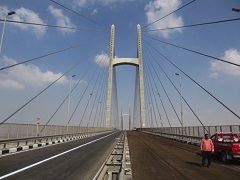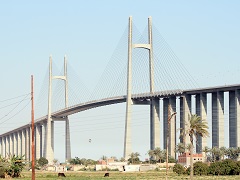- Home
- Countries & Regions
- Middle East
- Egypt
- Activities in Egypt
- Suez Canal Peace Bridge (Japan-Egypt Friendship Bridge)
Activities in Egypt
Suez Canal Peace Bridge (Japan-Egypt Friendship Bridge)
Background and Objective
The Sinai Peninsula has a unique strategic location. It is the crossing link between Africa, Asia and Europe overlooking two main seas; the Mediterranean Sea to the North and Red Sea to the South. On its West, there is the Suez Canal which is one of the most important sea routes in the world. Sinai's unique location provides Egypt with a strategic significance as an entrance to Africa as well as to Asia and Europe.
Sinai is entitled to have a greater economic role for Egypt, thus, linking the Sinai Peninsula with the rest of the Egyptian lands through the bridge was a high necessity to boost the economic development in Egypt.
Project Summary
Grant Project (June 1997 – October 2001)
The Japanese government provided a grant of JPY 13.5 billion to cover approximately 60% of the construction cost of the Suez Canal Peace Bridge (Japan-Egypt Friendship Bridge) that reached JPY 22.5 billion.
The bridge was constructed with total length of 9 km, which is composed of 4 km of bridge part (Cable Stayed / middle metallic part) and a 5 km approach road part. The clearance between the bridge girder and the water level is 70 m to allow all types of vessels to transit the Suez Canal without restriction. The pylons are shaped as the Pharaonic obelisks in ancient Egypt, and their height reached 154 m.
Egypt's General Authority for Roads, Bridges and Land Transport (GARBLT), affiliated to the Egyptian Ministry of Transport, had supervised the executing Egyptian companies of the eastern and western parts of the bridge with a height of 49.5 m on both sides of the canal, and cooperated with the Japanese executing companies that constructed the cable stayed / middle metallic part over the canal, which is the main part of the bridge.
Technical Cooperation
Phase I: JICA conducted the "Feasibility Study for Crossing Structure over the Suez Canal" from June 1995 till October 1996 to decide the best option for linking the Sinai Peninsula with the rest of the Egyptian lands that concluded that a bridge shall be established at Qantara close to North Ismailiya.
Phase II: During the construction phases, technical experts were sent to participate in the construction of the Suez Canal Bridge. They transferred the latest techniques and knowledge to the Egyptian counterparts.
Phase III: After completing the construction of the bridge, JICA dispatched several Japanese experts from 2012 to 2016 to support the GARBLT in the normal routine maintenance works of this complex structure. JICA experts managed to share the necessary knowledge with the staff of GARBLT, and finally, the maintenance works were completed smoothly. It is believed that such routine and regular maintenance will help to maintain the lifetime of the bridge.


- About JICA
- News & Features
- Countries & Regions
- Our Work
- Thematic Issues
- Types of Assistance
- Partnerships with Other Development Partners
- Climate Change / Environmental and Social Considerations
- Evaluations
- Compliance and Anti-corruption
- Science and Technology Cooperation on Global Issues
- Research
- JICA Development Studies Program / JICA Chair
- Support for the Acceptance of Foreign HRs / Multicultural and Inclusive Community
- Publications
- Investor Relations
